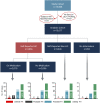The Prevalence and Genetic Spectrum of Familial Hypercholesterolemia in Qatar Based on Whole Genome Sequencing of 14,000 Subjects
- PMID: 35910211
- PMCID: PMC9337875
- DOI: 10.3389/fgene.2022.927504
The Prevalence and Genetic Spectrum of Familial Hypercholesterolemia in Qatar Based on Whole Genome Sequencing of 14,000 Subjects
Abstract
Familial hypercholesterolemia (FH) is an inherited disease characterized by reduced efficiency of low-density lipoprotein-cholesterol (LDL-C) removal from the blood and, consequently, an increased risk of life-threatening early cardiovascular complications. In Qatar, the prevalence of FH has not been determined and the disease, as in many countries, is largely underdiagnosed. In this study, we combined whole-genome sequencing data from the Qatar Genome Program with deep phenotype data from Qatar Biobank for 14,056 subjects to determine the genetic spectrum and estimate the prevalence of FH in Qatar. We used the Dutch Lipid Clinic Network (DLCN) as a diagnostic tool and scrutinized 11 FH-related genes for known pathogenic and possibly pathogenic mutations. Results revealed an estimated prevalence of 0.8% (1:125) for definite/probable cases of FH in the Qatari population. We detected 16 known pathogenic/likely pathogenic mutations in LDLR and one in PCSK9; all in a heterozygous state with high penetrance. The most common mutation was rs1064793799 (c.313+3A >C) followed by rs771019366 (p.Asp90Gly); both in LDLR. In addition, we identified 18 highly penetrant possibly pathogenic variants, of which 5 were Qatari-specific, in LDLR, APOB, PCSK9 and APOE, which are predicted to be among the top 1% most deleterious mutations in the human genome but further validations are required to confirm their pathogenicity. We did not detect any homozygous FH or autosomal recessive mutations in our study cohort. This pioneering study provides a reliable estimate of FH prevalence in Qatar based on a significantly large population-based cohort, whilst uncovering the spectrum of genetic variants associated with FH.
Keywords: FH; LDL-C; LDLR; dyslipidemias; familial hypercholesterolemia; hypercholesterolemia; monogenic.
Copyright © 2022 Diboun, Al-Sarraj, Toor, Mohammed, Qureshi, Al Hail, Jayyousi, Al Suwaidi and Albagha.
Conflict of interest statement
The authors declare that the research was conducted in the absence of any commercial or financial relationships that could be construed as a potential conflict of interest.
Figures




Similar articles
-
Assessing the genetic burden of familial hypercholesterolemia in a large middle eastern biobank.J Transl Med. 2022 Nov 3;20(1):502. doi: 10.1186/s12967-022-03697-w. J Transl Med. 2022. PMID: 36329474 Free PMC article.
-
Spectrum of mutations in Italian patients with familial hypercholesterolemia: New results from the LIPIGEN study.Atheroscler Suppl. 2017 Oct;29:17-24. doi: 10.1016/j.atherosclerosissup.2017.07.002. Atheroscler Suppl. 2017. PMID: 28965616
-
DIAgnosis and Management Of familial hypercholesterolemia in a Nationwide Design (DIAMOND-FH): Prevalence in Switzerland, clinical characteristics and the diagnostic value of clinical scores.Atherosclerosis. 2018 Oct;277:282-288. doi: 10.1016/j.atherosclerosis.2018.08.009. Atherosclerosis. 2018. PMID: 30270060
-
The molecular genetic basis and diagnosis of familial hypercholesterolemia in Denmark.Dan Med Bull. 2002 Nov;49(4):318-45. Dan Med Bull. 2002. PMID: 12553167 Review.
-
Spectrum of mutations of familial hypercholesterolemia in the 22 Arab countries.Atherosclerosis. 2018 Dec;279:62-72. doi: 10.1016/j.atherosclerosis.2018.10.022. Epub 2018 Oct 19. Atherosclerosis. 2018. PMID: 30415195
Cited by
-
A multi-ancestry genome-wide association study and evaluation of polygenic scores of LDL-C levels.J Lipid Res. 2025 Mar;66(3):100752. doi: 10.1016/j.jlr.2025.100752. Epub 2025 Feb 3. J Lipid Res. 2025. PMID: 39909172 Free PMC article.
-
Cellular and functional evaluation of LDLR missense variants reported in hypercholesterolemic patients demonstrates their hypomorphic impacts on trafficking and LDL internalization.Front Cell Dev Biol. 2024 Jul 24;12:1412236. doi: 10.3389/fcell.2024.1412236. eCollection 2024. Front Cell Dev Biol. 2024. PMID: 39114568 Free PMC article.
-
Genetic Spectrum of Lithuanian Familial Hypercholesterolemia Patients.J Cardiovasc Dev Dis. 2025 May 21;12(5):197. doi: 10.3390/jcdd12050197. J Cardiovasc Dev Dis. 2025. PMID: 40422968 Free PMC article.
References
LinkOut - more resources
Full Text Sources
Miscellaneous

